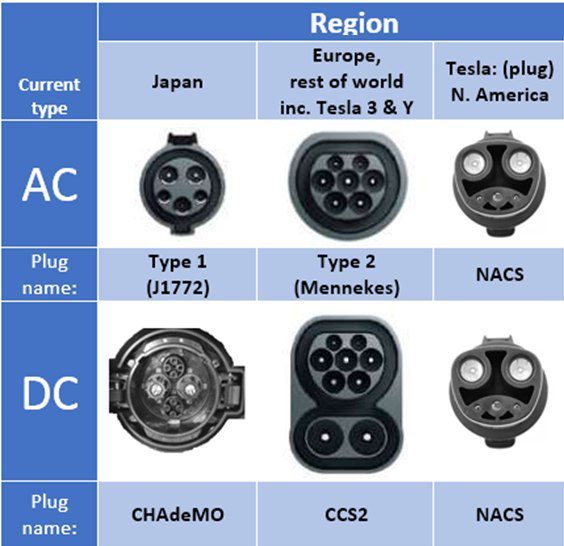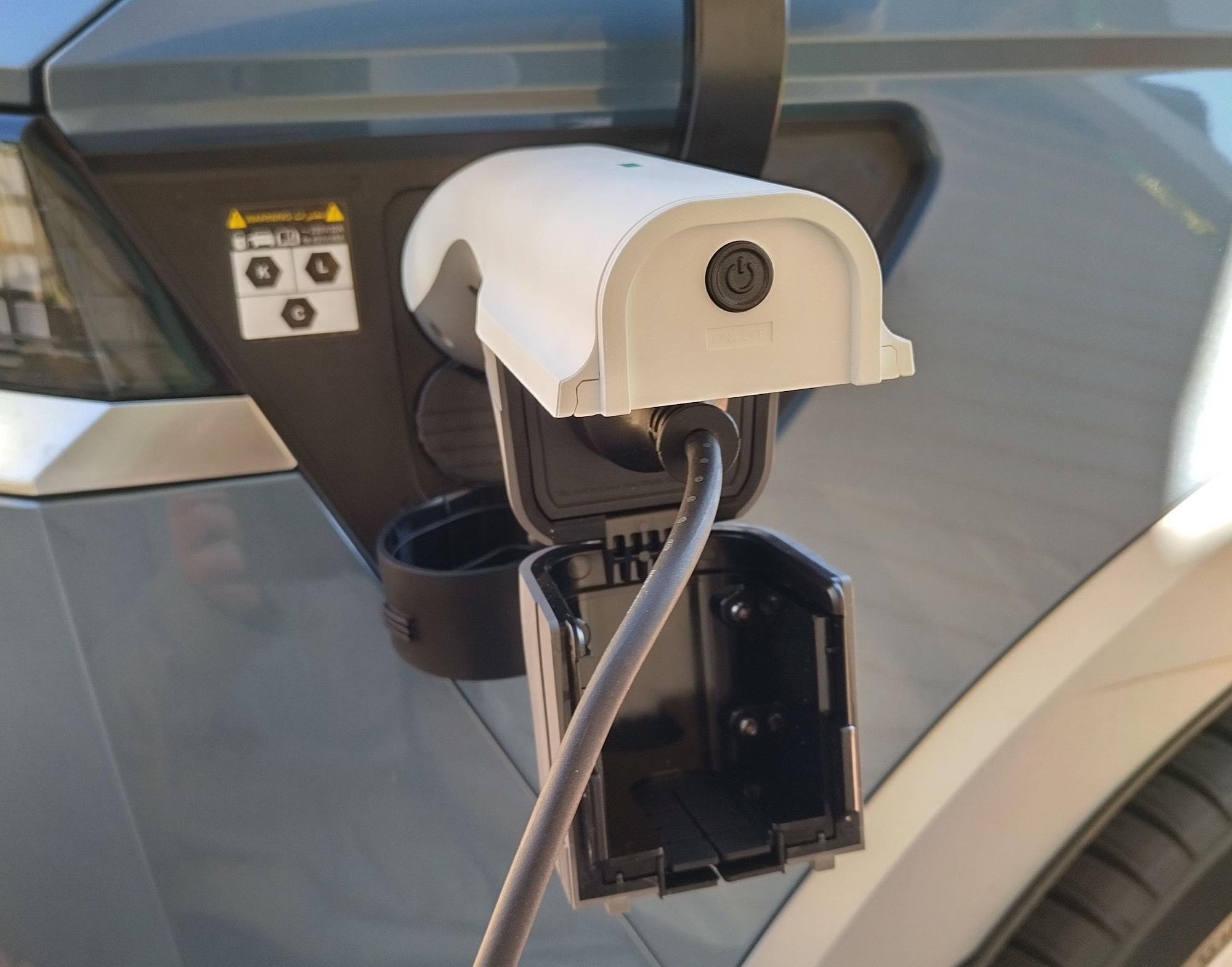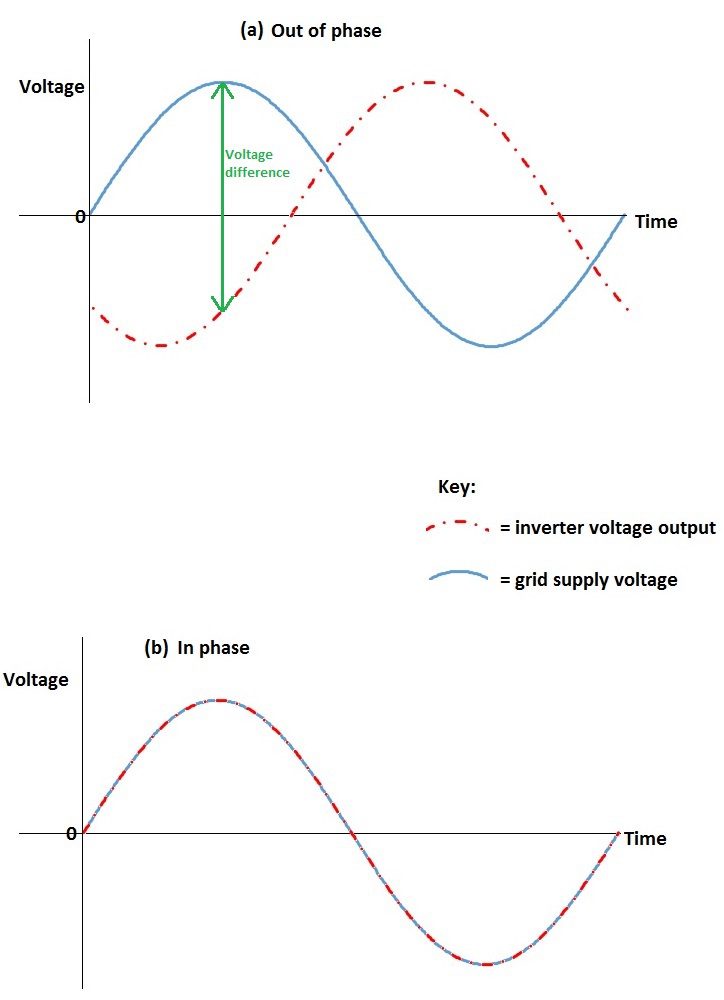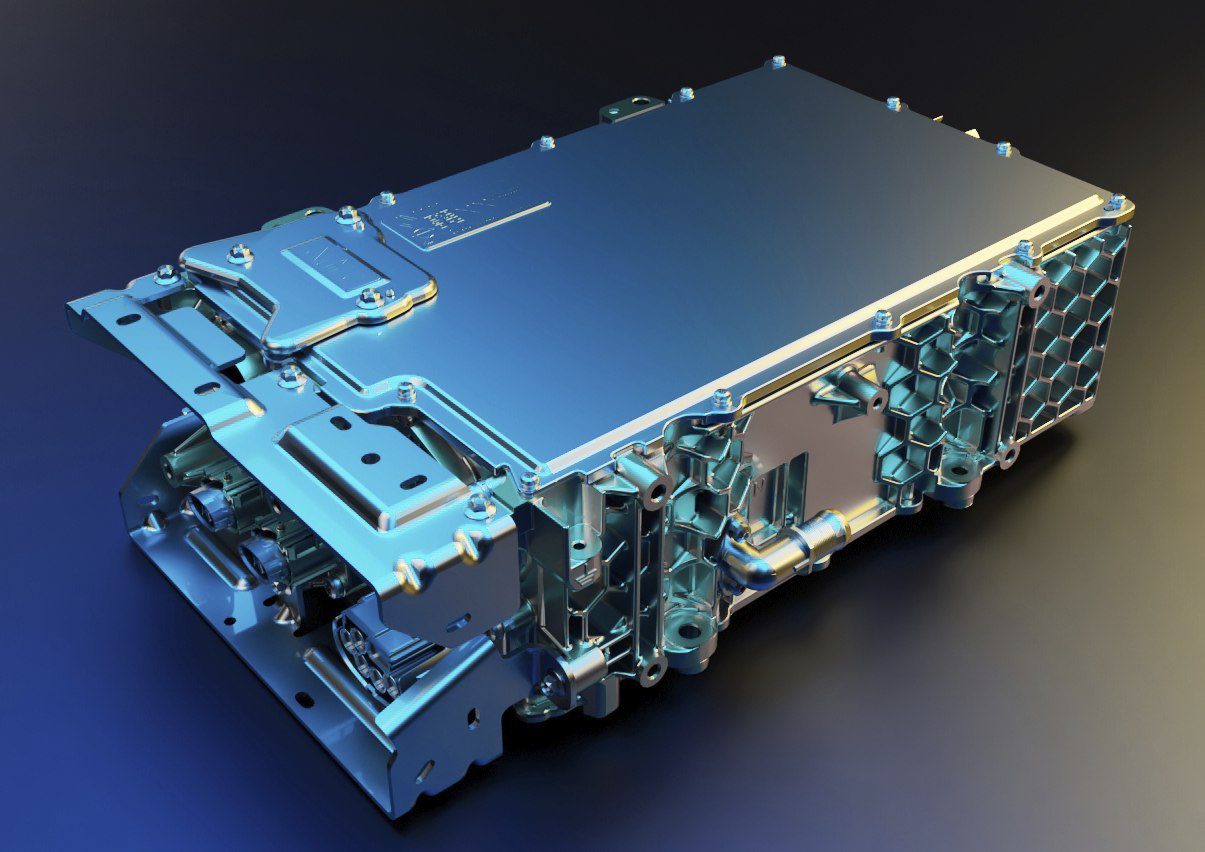Putting electricity into an EV is easy. Plug in a power lead at home and the car’s inbuilt charger will convert your AC power to the DC needed to charge the battery. Plug in at the ever-expanding network of DC fast-chargers and DC will be provided directly to the battery – generally at a much faster rate.
Getting power out of an EV is also not new, but it has been rarer. A standard for getting power back out of the original DC connector (the Japanese CHAdeMO system) was published back in 2014.
Cars fitted with the CHAdeMO plug have therefore long been capable of providing power from the battery. However CHAdeMO lost the Plug War and CCS2 has become the major world standard outside of North America and Japan and CCS has not (until recently) been capable of providing power out from the battery. (I am by the way ignoring China who have their own, unique, standards for AC and DC plugs).

The three major world standards for EV charge plugs
First though, I need to explain the three ways power from an EV can be provided. These are:
- Vehicle to Load (V2L)
- Vehicle to Home (V2H – sometimes called Vehicle to Building, or V2B)
- Vehicle to Grid (V2G)
Collectively, these are referred to as V2X.
Vehicle to Load (V2L):
This is the provision of power to run ordinary AC appliances from the car. For example, tradies recharging their power tool batteries or a family on a weekend camping trip running cooking and lighting systems.

Ford F150 Lightning powering a building site through V2L. Image: Ford US.
Implementing V2L:
Under the CHAdeMO system, you used DC electricity from the car and you had to plug in a specially designed inverter with AC outlets on it. These inverters were big, heavy and expensive items not conducive to being packed neatly in the boot!

Setec DC to AC V2L system. Image: Setec Power
Being later on the scene, CCS learnt from this and implemented V2L through modifying the car’s in-built charger. To get AC from the CCS system, you plug a small adaptor into the AC part of the CCS socket and, provided your car has a bidirectional charger, you get AC out.

Hyundai V2L adaptor. Image: B Gaton
The result was a much smaller, simpler (and cheaper) V2L set-up with an adaptor that could stash into almost any vehicle storage pocket. If you can get one, a CHAdeMO V2L system will cost you upwards of $4,000 to $5,000. (And that ‘if’ is because it is hard to find one approved for Australian use). On the other hand, CCS V2L adaptors are so cheap they often get thrown in with the car1.
Vehicle to Home (V2H):
This provides power to the building, but NOT out past the switchboard and into the street. When V2H operates, the building is isolated from the grid and runs exclusively off the EV. Good for running a home during a power failure, depending on how the system is set up there will likely be a short gap between the grid going off and the V2H system picking up the slack … and ditto on return of the grid and switching back.
Implementing V2H:
Like for V2L, the CHAdeMO system provides DC out and needs a specially designed inverter. For V2H, the inverter also includes electronics to sense when grid power is available. This box is usually mounted on the wall next to the switchboard and incorporates a ‘break-before-make’ change-over switch that is controlled by the electronics. (‘Break-before-make’ means the grid is fully disconnected before the alternate supply is connected, and vice-versa).
All currently available CCS V2H systems use the same technique – DC out from the car and an inverter box on the wall to convert the DC to AC. By the way, although no CCS V2H systems are approved for use here in Australia, this is changing soon.
Vehicle to Grid (V2G)
V2G allows for the power network to call on a battery to provide power to the grid when needed. Home back-up batteries can already do this – although it is not widely available to do so – as do the grid-scale storage batteries that are currently proliferating throughout our electricity network. When EVs have this feature, they will in effect become a very large extra storage and supply resource. EVs without bidirectional charging are useful for soaking up excess generation through smart-charger control – but V2G capable EVs will become as integral part of a fully renewable electricity supply system as they can not only soak up excess generation, they can provide temporary support in times of overload.
Implementing V2G:
Both CHAdeMO and currently available CCS V2G systems utilise an external DC to AC inverter system. There is an added complication when connecting to the grid though – the AC waveform timing from the inverter must exactly match that of the grid. In technical terms – they need to be ‘in-phase’: connecting out-of-phase AC lines can have catastrophic consequences on the systems involved due to large voltage differences between the two! This means the V2G box must include electronics to sense the grid’s waveform timing and adjust the inverter output to match. (See graphs).

Two AC voltages (a) out of phase and (b) in phase.
Note: In (b) there is no voltage difference between the two outputs. In (a) the voltage difference is measured between the two lines at the same point in time – and is very large!
As a result – current V2G systems use DC out from the battery and manufacture a matching, in-phase AC waveform to enable integration with the grid. The inverter must also sense when the grid is off and either isolate the building from the grid to keep the building running, or turn off entirely. (As do all grid-connected solar voltaic systems and home battery systems). By the way, if this ‘anti-islanding’ feature didn’t exist: line-workers could be electrocuted from solar and battery supplies back-feeding the grid when they are working on supposedly disconnected street cabling.
Cost of V2X systems.
As you can now see: to do V2X, CHAdeMO needs expensive inverter boxes to do all three of V2L, V2H and V2G. CCS dramatically reduced the cost of V2L by modifying the car’s inbuilt charger and used a simple adaptor instead. However CCS still uses the same type of expensive inverter box to do V2H or V2G.
For some time now I have speculated that if CCS could do the same trick for V2H/G as it did for V2L, then the cost of the inverter would be removed and CCS V2H/G systems would be a lot cheaper.
However, the answer I always got from experts in the field was that this was impossible. The reasons they gave were:
- the battery charge level communications needed were only available with DC charging systems, and
- you needed an inverter with inbuilt electronics to make the matching in-phase AC waveform.
So now I can come back to a recent announcement by Renault about their upcoming Renault 5 EV. It seems they didn’t read the ‘only DC output for V2G’ playbook. The upcoming Renault 5 will not only include V2G, it will do so using the car’s inbuilt bidirectional charger and provide AC (not DC) to the wall mounted box interfacing with the building switchboard!

Renault’s new bidirectional charger for V2X technology. Image: Renault
According to Renault, their ‘Mobilize V2G’ service will make it possible to:
- put charging on hold during peak hours;
- inject power back into the home (such as when electricity is expensive) plus into the grid when demand is high and
- enable charging when electricity prices are cheapest.
This system will involve four components:
- a bidirectional on-board charger incorporating V2G technology;
- a bidirectional terminal they call the ‘Mobilize Powerbox’;
- a ‘Mobilize electricity’ contract that will monetise energy injected back into the grid through automated bidirectional charging management;
- a smartphone app used to program bidirectional charging, including the ability to set the time when the vehicle is going to be used next and the desired battery level at that time.
Their system will also use the same type of simple, cheap adaptor for V2L as is used by Hyundai, MG, BYD, etcetera.
A key question now is whether they will offer the same system when the R5 arrives here, or only V2L. In the past, Renault Australia have not provided the connected vehicle services they offer in Europe, so it might be a stretch to expect it to happen here. We shall have to wait and see.
Notes:
- If you do have to buy one, the Hyundai version is around $175.

Bryce Gaton is an expert on electric vehicles and contributor for The Driven and Renew Economy. He has been working in the EV sector since 2008 and is currently working as EV electrical safety trainer/supervisor for the University of Melbourne. He also provides support for the EV Transition to business, government and the public through his EV Transition consultancy EVchoice.

